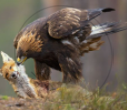Advertisements
Advertisements
प्रश्न
Distinguish between the following: Parasitism and Mutualism.
उत्तर
| Parasitism | Mutualism | |
| i. |
In parasitism, only one species (parasite) is benefited and the interaction is detrimental to other species (host). |
In mutualism, both species are benefited. |
| ii. | The parasite needs a host, but the host does not need the parasite. | Both species need the presence of each other. |
| E.g. | Cuscuta, a parasitic plant commonly found growing on hedge plants. | Lichen represents the mutualistic relationship between a fungus and photosynthetic algae or cyanobacteria. |
APPEARS IN
संबंधित प्रश्न
Name important defence mechanisms in plants against herbivory.
Name and explain the interaction that is seen between clownfish and sea anemones.
Name the type of association: Crow feeding the hatchling of Koel
Explain different population interactions with examples.
Define population growth. Explain different types of age pyramids.
Identify the interspecific interaction depicted in the following figure.

Parasitism can be conectly represented as ____________.
Match the Columns.
| Column A | Column B | ||
| i. | Lice on humans | a. | Endoparasites |
| ii. | Ectoparasites on marine fishes | b. | Grows on hedge plants |
| iii. | Cuscuta | c. | Ectoparasites |
| iv. | Plasmodium and humans | d. | Copepods |
Define ectoparasite and endoparasite and give suitable examples.
Give one example for the following type.
Biological control agent
